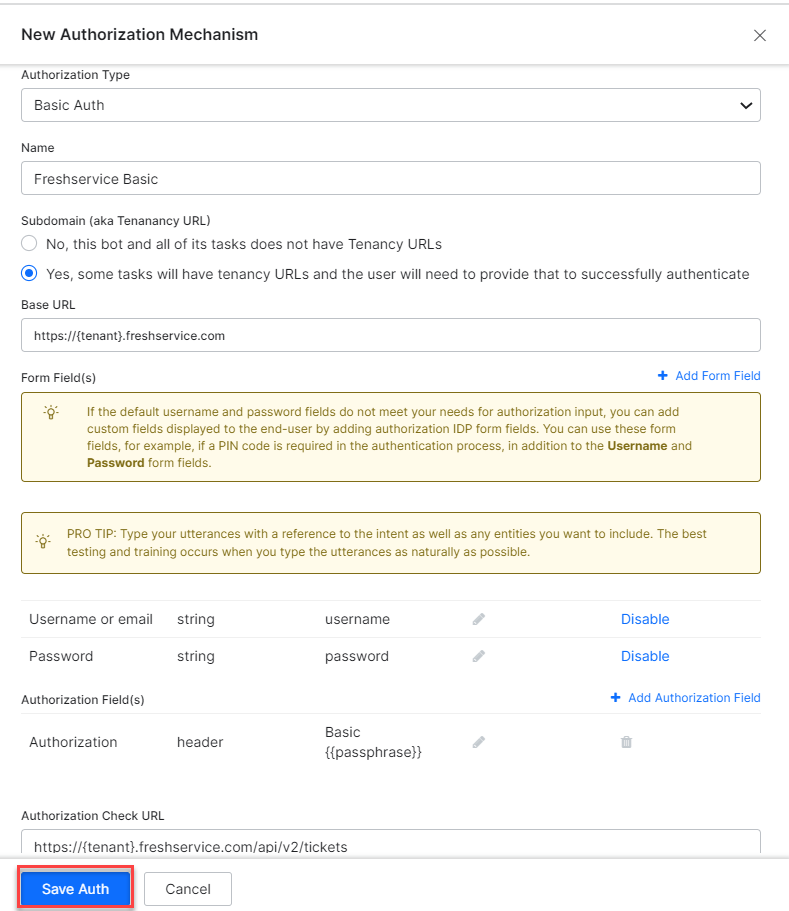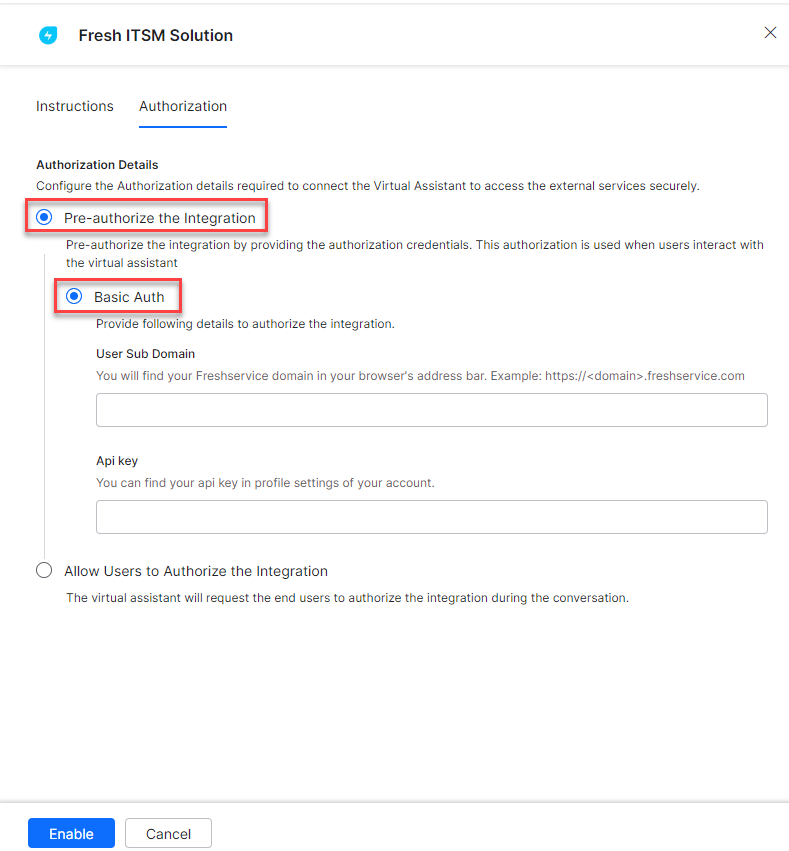The XO Platform lets you easily connect the Freshservice integration to allow you to create, view, update, and delete tickets in the system to manage your IT services. Click the Freshservice link to learn more.
This document explains the Freshservice configuration steps to enable, authorize, configure, and install the pre-built templates.
Authorizations Supported
The Kore.ai XO Platform supports basic authentication to allow Freshservice integration to exchange data. For more information, read the Bot Authorization Overview article.
The Kore.ai XO Platform supports the following authorization types for the Freshservice integration:
- Pre-Authorize the Integration – To make the integration process smoother for developers and customers, you can pre-authorize it by providing the necessary authorization credentials to obtain the access token.
- Allow Users to Authorize the Integration – This method requires the end user to provide credentials during the conversation for authorization. This authorization process involves requesting permission for Kore.ai’s Freshservice app to access an access token at runtime. To learn more about Freshservice account types, see Freshservice Documentation.
Step 1: Enable the Freshservice Action
Prerequisites:
Before enabling the Freshservice action, complete the following prerequisites:
- If you don’t have Freshservice account credentials, create an account in Freshservice and note down login credentials. For more information, see Freshservice Documentation.
- Copy the API Key and Domain name of your Freshservice account and keep them for future use to enable the integration.
Steps to enable the Freshservice action:
- Go to Build > Integrations > Actions.
- Once you click the Actions menu, all integrations are shown in the Available region. Select the Freshservice action.

Pre-authorize the Integration
Basic Auth
You can authorize the integration using your credentials. The developer authorization lets you authorize the integration with preconfigured Kore.ai’s app with the Basic Auth option.
Steps to authorize a Freshservice action using developer credentials:
- Go to Build > Integrations > Actions and select the Freshservice action.
- In the Configurations dialog, select the Authorization tab.
- Enter the following details:
- Click Enable. When you configure the action for the first time, the Integration Successful pop-up is displayed.

Note: The Freshservice action is moved from Available to Configured region.
Allow End User to Authorize
You can authorize the integration at a user level with their login credentials. The user authorization process involves requesting permission for Kore.ai’s Freshservice app to access an access token at runtime. You can also use the basic auth profile to let a user configure the integration at runtime.
Steps to authorize a Freshservice action at a user level:
- Go to Build > Integrations > Actions and select the Freshservice action.
- In the Configurations dialog, select the Authorization tab.
- Enter the following details:
- Authorization Type – Select the Allow Users to Authorize the Integration option, and then select the Basic Auth option.
- Create your authorization profile to obtain an access token and use it to complete integration without using Kore.ai’s Freshservice app for authorization. To create a profile, click the Select Authorization drop-down and select the Create New option.

- Select the type of authorization mechanism. For example, select the Basic Auth option. To create Basic Auth profiles, see Bot Authorization Overview.

- Enter the following authentication credentials for the Basic Auth mechanism:
- Name – Enter the name for the Basic Auth profile.
- Select Yes; some tasks will have tenancy URLs, and the user must provide the URLs to authenticate successfully.
- Base URL – Enter the base tenant URL for the Freshservice instance.
- Authorization Check URL – Enter the authorization check URL for your Freshservice instance.
- Description – Enter the description of the basic authentication profile.
- Click Save Auth to save the authorization profile.

- Select the new Authorization Profile, which you created to complete integration.
- Click Enable. When you configure the action for the first time, the Integration Successful pop-up is displayed.

Step 2: Install the Freshservice Action Templates
Once you have configured a Freshservice integration, you can explore and install action templates.
Steps to install action templates:
- On the Integration Successful dialog, click the Explore Templates button to view the templates.
>
- In the Integration Templates dialog, click the Install button to begin the installation.

- Once the template is installed, click the Go to Dialog button to view the dialog task.
- Once all templates are installed, a dialog task for each template is auto-created.

- Select the desired dialog task from the templates and click Proceed. For example, select the Create a Ticket task.

- Once you click Proceed, the dialog task is auto-created, and the canvas opens with all required entity nodes, service nodes, and message scripts.


